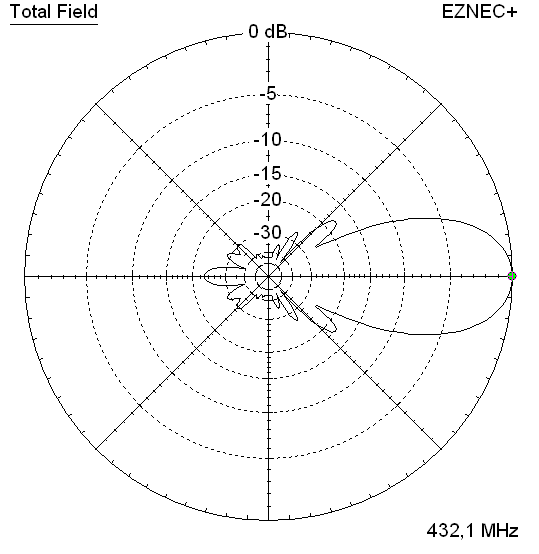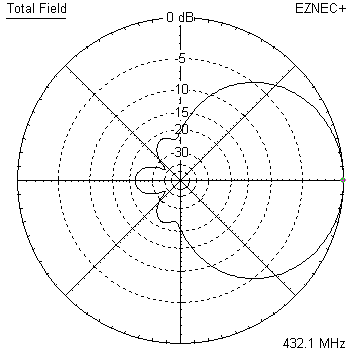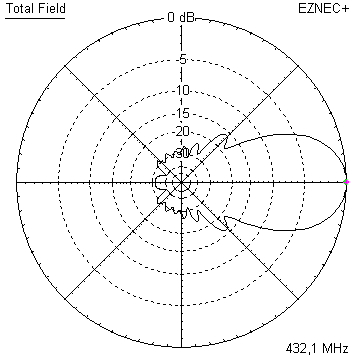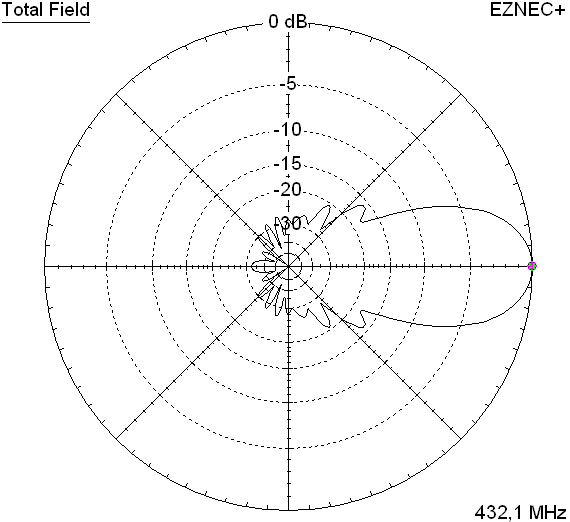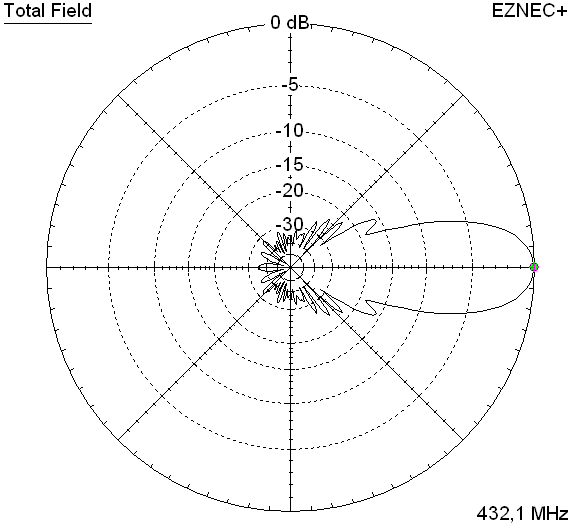
23 ele.Yagi by F5JTM with straight Dipole
Seti Yagi (1420 MHz) with good side and rear lobe suppression but enough bandwidth for feasible builds
I am proud to host Serge, F5JTM with his low side lobes 23 elem. Yagi design:
Serge does not have an own website but this nice design, so I decided to share a bit of my webspace.
Here is Serge's email address for any requests by other Seti Yagi and Fractals Antennas enthusiasts:
 and link to his Facebook web
and link to his Facebook web

Current distribution


Short Screenshot Movie showing rotating 3D Pattern
To watch the rotating 3D Pattern movie by F5JM click here pse
Performance Data
Specs: with 2 mm elements @ 1420 MHz
Gain vs. isotr. Rad. 19.2 dBi Gain vs. Dipole 17.1 dBD -3 dB H-plane 21.5 deg. -3 dB E-plane 22.4 deg. F/B -25.4 dB F/R -25.4 dB Impedance 50 ohms Mechan. Length 1877 mm incl. 2 x 30 mm stand off Electr. Length 8.61 λ Stacking dist. h-pol. top-to-bottom 0.54 m or 1.78 ft side-by-side 0.57 m or 1.85 ft
How many OMs have been looking up this design?
Geometry
Element and Positions on Boom table prepaired by F5JTM:
(Ø 2 mm Elements and Ø 3 mm Dipole)
Pos. NEC 1/2 elt Full Length
Ref.: 0 50.5 101.0
D.E : 45.1 49.5 99.0
D1 : 62.4 47.3 94.6
D2 : 101.6 45.4 90.8
D3 : 148.6 45.0 90.0
D4 : 206.3 44.3 88.6
D5 : 284.7 43.6 87.2
D6 : 369.4 42.9 85.8
D7 : 462.5 42.3 84.6
D8 : 556.4 41.9 83.8
D9 : 648.5 41.5 83.0
D10 : 743.7 41.2 82.5
D11 : 841.0 41.0 82.0
D12 : 941.0 40.5 81.0
D13 : 1035.1 40.2 80.5
D14 : 1138.2 39.9 79.7
D15 : 1239.2 39.6 79.1
D16 : 1338.3 39.3 78.5
D17 : 1436.5 39.0 78.0
D18 : 1534.3 38.6 77.2
D19 : 1633.6 38.3 76.6
D20 : 1724.2 38.0 76.0
D21 : 1817.3 37.7 75.4
Building hints:
For BC valid for microwaves
Elements can be mounted conductive through boom. For a real press fit we heat the boom to maybe +70 C. Then drill holes 2.00 mm or 1.95 mm into the very hot boom. These holes will shrink with decreasing temperature. Then place elements in a deep freezer (-20 C) and push into the hot boom. The element diameter will grow with increasing temperature to ambient numbers. Thus an extra tight press fit can be achieved.
Try with a spare bit of boom and element rods to find right drill hole diameter and temperature handling!
Radiation Pattern and VSWR Plots
Elevation and Azimuth plot at 432.1 MHz


SWR and Return Loss plots - simulated with 4nec2

Downloads
NEC2 (4nec) file of this Yagi with Ø 2 mm ele.
NEC2 (4nec) file of this Yagi with Ø 2 mm ele. as 4bay
Stacking
As on 1420 MHz the Y-factor = T_earth / T_sky is so high, I see little chances to
improve an array's RX performance by using "Over Stacking" distances. However, depending on
the level of local QRM it might be worthwhile to try a decreased distance, especially in the H-plane.
Stacking Dist. DL6WU Formula H-plane 0.57 m E-plane 0.54 m
A 4 bay Yagi stack

Short Screenshot Movie showing rotating 3D Pattern
To watch the rotating 3D Pattern movie by F5JM click here pse
Elevation ad Azimuth plot and data of 4 Yagi bay using DL6WU stacking distances


Gain vs. isotr. Rad. 25.1 dBi Gain vs. Dipole 23.0 dBD F/B -24.9 dB F/R -24.9 dB T_ant 19.6 K (T_pattern = 14.0 K / T_loss = 5.9 K)* G/T 12.13 dB*Theoretical numbers - these do not include phasing line losses
nor imperfections caused by H-frames or mast poles etc.
*) T_sky = 10 K, T_earth = 290 K
Screenshot of TANT for this 4 Yagi stack

Symmetrising 50 to 50 ohms feedline to 1420 MHz DE: 3 x 1/4 λ line
The principle is similar to the 1/4 Lambda coax. Adding 2 x 1/4 λ or a 1/2 λ line does not change anything but allows
to form a gentle bow below the boom or until behind the Reflector. Follow practical construction hints on "Building a Yagi" page.

An example for 432 MHz with bent DE

 Attenzione!
Take care when lengthening the coax, measure the actual electrical length instead of considering v-factors specified in a catalogue only.
Attenzione!
Take care when lengthening the coax, measure the actual electrical length instead of considering v-factors specified in a catalogue only.A good choice may be the diam. 5 mm PTFE coax RG-142 B/U: real resonate length (1420 MHz as 3/4 Lambda) shield-shield is around 104 mm
 Find more information on Phasing & Matching Lines page
Find more information on Phasing & Matching Lines page 73, Hartmut, DG7YBN

